How to grow your own science experiment
Test the power of fertilizer with this garden-variety experiment
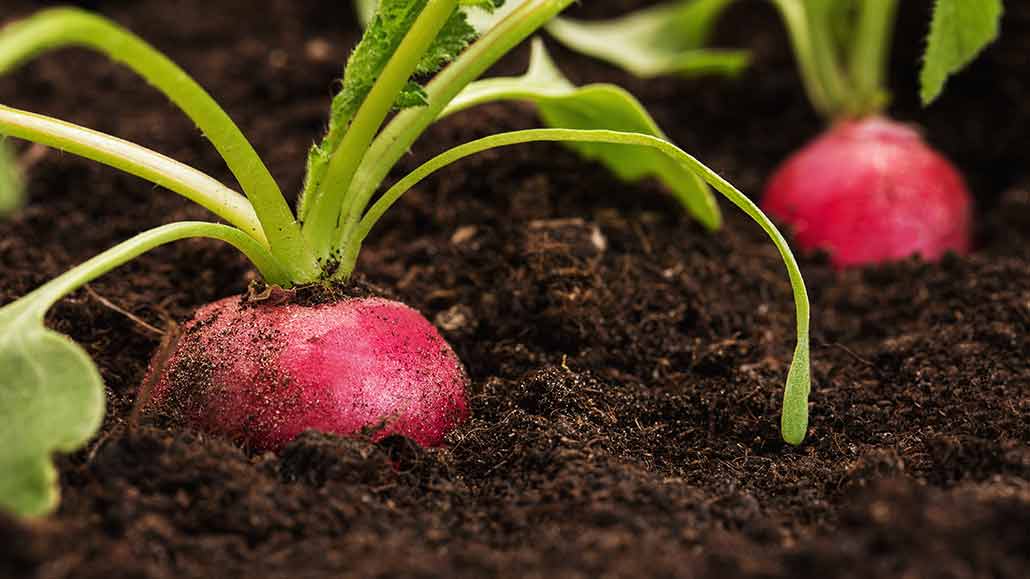
Does fertilizer make plants bigger? My editor and I grew radishes to find out. Spoiler: Ours did not look this good.
Nastco/iStock/Getty Images Plus
This article is one of a series of Experiments meant to teach students about how science is done, from generating a hypothesis and designing an experiment to analyzing the results with statistics. You can repeat the steps here and compare your results — or use this as inspiration to design your own experiment.
Sometimes when you tend a garden, your plants end up looking oddly sad. Maybe they’re short and stubby, or not as leafy as you’d like. The first thing some people might suggest is to add a little fertilizer to make your plants bigger and taller. But will fertilizer do that? Here’s an experiment to find out.
Plants are marvels. Using carbon dioxide, light and water, they can make sugar out of (almost) thin air. “Most of a plant is made from carbon dioxide,” explains Jessica Savage. “A lot of times people think the plant grows or is built out of things from the soil. But it’s growing out of the air.” As a botanist, Savage studies plants. She works at the University of Minnesota in Duluth.
Plants can’t quite survive on air alone. They do need a few other elements. For example, the backbone of DNA — the molecule with the plant’s genetic instructions — has phosphorus atoms in it. So does ATP, the chemical that helps transfer energy around a cell. Proteins — molecules that do much of a cell’s work — need nitrogen atoms.
Usually, plants get nitrogen and phosphorus from the soil. Some plants are known as nitrogen-fixing. They can pull nitrogen from the air and transform it into nitrogen-containing molecules that plants can use. But most plants can’t do this. They have to rely on other plants or fungi to transform nitrogen for them. They also have to get phosphorus in the form of phosphate (phosphorus bound to four oxygen atoms), which is broken down from rocks in the earth.
Soils have plenty of nitrogen and phosphorus in them. But many do not. Gardening fertilizer contains nitrogen and phosphorus in forms that plant roots can easily slurp up. With all the extra nutrients, the fertilizer ads say, plants will grow bigger and faster.
“If [plants] are given a lot of light and nitrogen, they might increase chlorophyll and photosynthesis,” Savage says. That might mean the plants end up with more leaves. With more leaves, she notes, they’ll have more sugar. Those sugars can be made into more plant materials. With fertilizer, Savage explains, plants should get bigger, because they’ll make more sugar.
The question is whether the fertilized plants will have bigger roots, bigger leaves or both. “Will they focus on growing above or below ground?” she asks.
That’s a hypothesis I can test. My hypothesis is that fertilized plants will be bigger than those that are not fertilized.
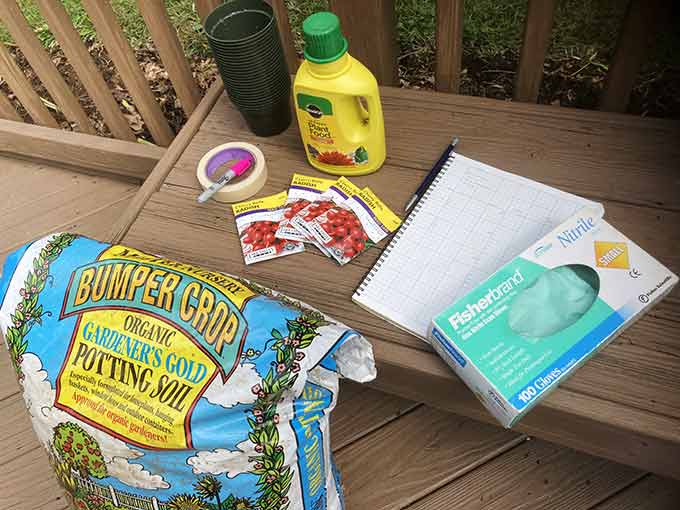
Grow radish, grow
I bought several packs of seeds, 24 small plastic seed pots, plant fertilizer and potting soil. I made sure the soil didn’t contain added fertilizer.
I wanted something that I could grow quickly, that wouldn’t take up a lot of space and that wouldn’t get too big. I ran this experiment in early fall in Maryland. So I knew I needed a plant that could grow when it’s cool. I picked radishes, which grow well in the early fall or spring. Some varieties can grow a full radish in only 21 days.
-
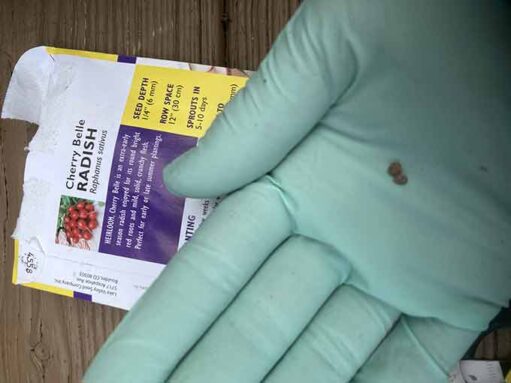
Radish seeds are VERY tiny. Keep track to make sure you don’t lose any. B. Brookshire -
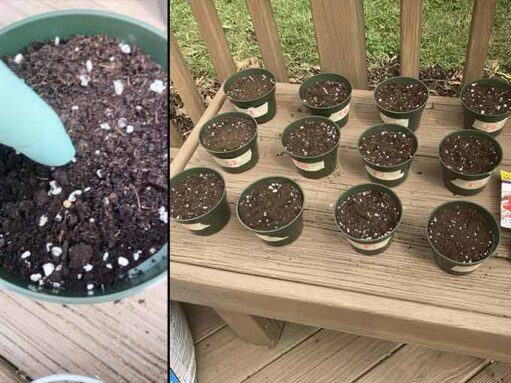
Make a small hole about the depth of your fingertip, push in the seed and cover (left). You also want to keep your plants together, so they get the same amount of sun and rain. Label them all so you know which is fertilized and which is not. B. Brookshire
I kept 12 of the pots and one pack of seeds for myself. I gave the other 12 pots and the other packet of seeds — along with some fertilizer and soil — to my editor, Sarah Zielinski. This was to provide an additional control for location. After all, what if my yard just happens to be much better for growing plants? What if it’s worse? By splitting the plants up between my yard and Sarah’s, I hoped to make sure that any difference with the plants came from the fertilizer.
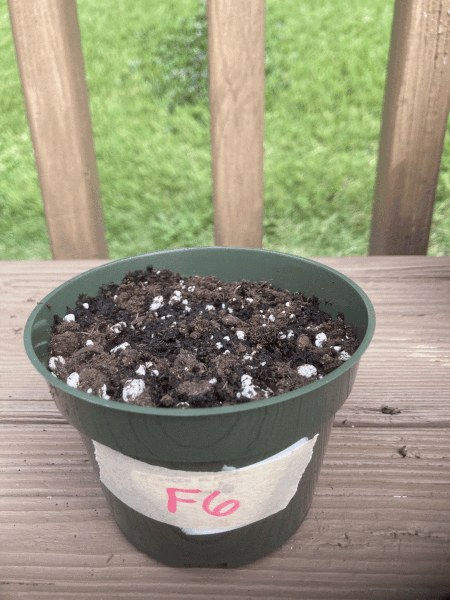
Sarah and I planted our seeds. Sometimes, seeds don’t sprout. So we carefully planted four evenly spaced seeds in each pot. Six of my pots (and six of Sarah’s) served as controls — pots that would not get fertilizer. Our other six were treated with fertilizer. For each of us, this added up to 24 control seeds, and 24 seeds that would get fertilizer.
It’s important to read and follow the instructions for the type of fertilizer you use. (Mine required mixing a tiny capful of liquid with five gallons of water.) Too much can cause fertilizer burn, where plants brown or even die. That’s because the nitrogen in fertilizer mix is in the form of a salt called ammonium nitrate. Such salts in the soil can cause water to leave the plant and head toward the salty soil — a process called osmosis. This can make the plant dry out and look burned.
We watered all the plants equally with clean water every other day (unless it rained). Once a week, we applied fertilizer to half the pots. We also took pictures every day, so we could see the plants change over time.
As I expected, many of our seeds didn’t sprout. In fact, only about a fourth of mine sprouted. Sarah has a greener thumb. She successfully grew half of hers.
Radishing results
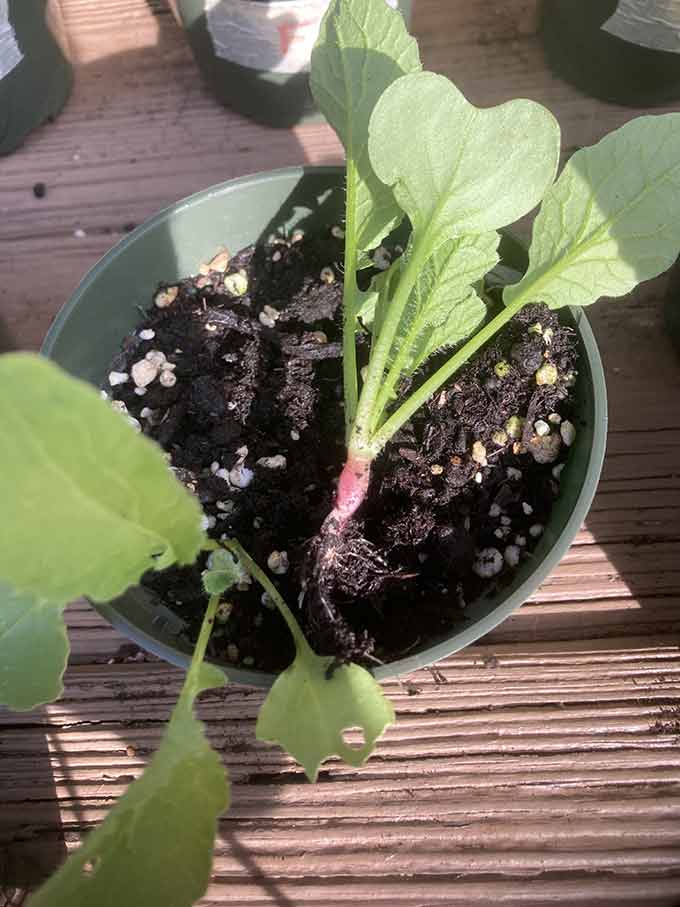
Day 21 was the moment of truth! Sarah and I pulled out the radishes, weighed them and measured the leaves and roots.
I pulled out my first radish — and was pretty disappointed.
While these plants can mature in 21 days, that doesn’t mean they always do. Our radishes were pretty puny. But that’s not a bad thing. After all, if all the radishes had grown until they couldn’t get any bigger, it might be harder to see any differences from the fertilizer.
Unfortunately, the radishes were so small that they weighed less than one gram. Most home kitchen scales don’t measure masses that small. Sarah and I were stuck measuring the length of the roots and leaves to see if there was any difference.
We started by counting the leaves on each plant. Together, we grew a total of 30 plants that received no fertilizer. These control plants had an average of 4.1 leaves. We also grew 24 plants in our fertilized pots. These had an average of 5.3 leaves. It seems the fertilized plants had more leaves than control plants.
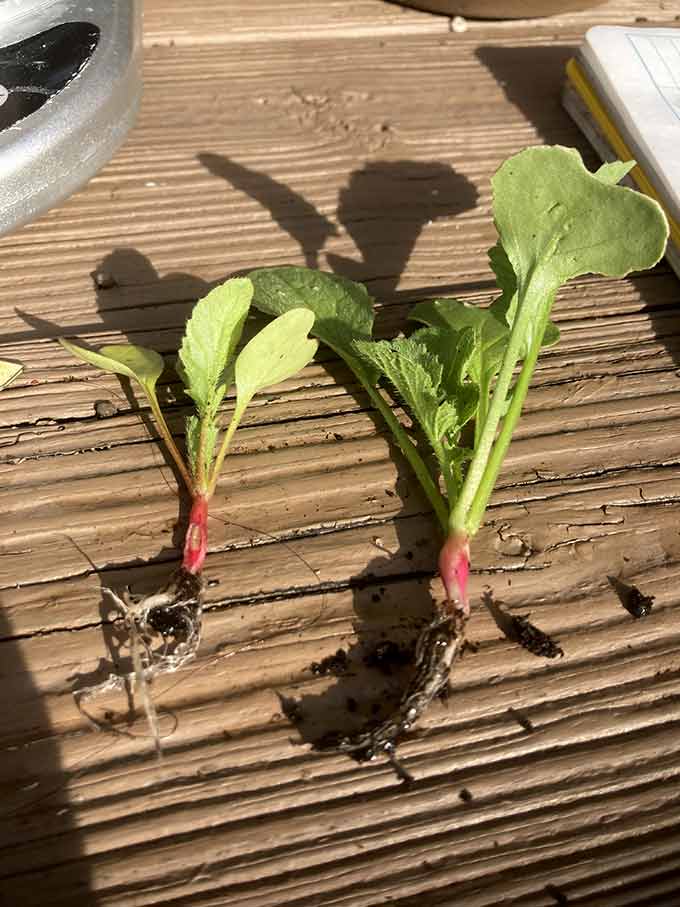
But that doesn’t mean the difference was due to the fertilizer. To find that out, I need to run statistics — tests I can use to interpret my data. In this case, we have two groups — fertilized and control. I used a t test, which can be used to compare two groups to each other. There are lots of sites online that will let you copy and paste in your data. I used this one from GraphPad.
A t test gives you a p value. A p value is a measure of the probability that just by chance I would see a variation between the groups as big as the one I measured. Usually, it’s expressed as a decimal, such as 0.05. That would be a five percent likelihood that I would get a difference as big or bigger than the one I saw if there was no real difference between the groups. Scientists often consider p values smaller than 0.05 to be meaningful — what they call statistically significant.
In this case, the p value between the fertilized and control leaves was 0.0001, or 0.01 percent. That difference is statistically significant. But that doesn’t tell you if the difference between the two is a big one. A difference can be very small and still be statistically significant. To find out if I have a big difference, I need to run a test called a Cohen’s d. You can also run that for free online. I used the calculator here.

For the Cohen’s d calculation, I need a number called the standard deviation. This is the amount by which each set of data differs from the mean (or average). To find that, I went to my data in Microsoft Excel, typed in the function “= STDEV” and highlighted my data set. I plugged into my calculator the mean, the standard deviation and the number of plants in each group.
My Cohen’s d was 1.3. Scientists usually consider any number over 0.8 to be a large difference. So it appears that our fertilized plants had more leaves than our non-fertilized controls, and that the fertilizer made a big difference in the number of leaves.
We also measured the length of the leaves and the length of the roots. I’ve included the p values for each one and the Cohen’s d in the table below. Fertilized plants had longer roots, but that difference was not big. They also had longer leaves, and here the difference was again large.
-
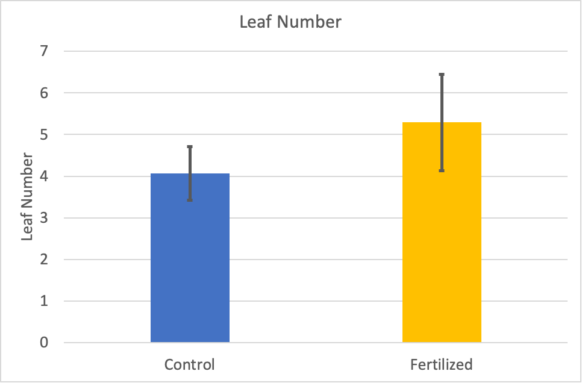
Fertilized plants (right, yellow) had more leaves after three weeks than the control plants (left, blue). B. Brookshire -
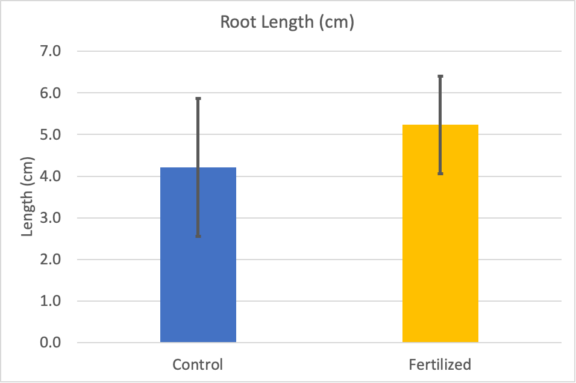
Fertilized plants (right, yellow) had longer roots after three weeks than the control plants (left, blue). But the difference was pretty small. B. Brookshire -
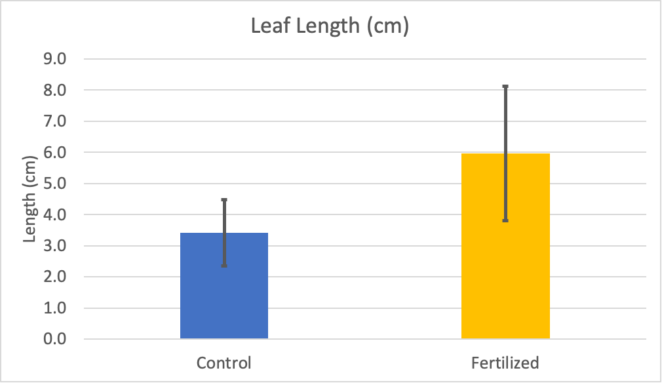
Fertilized plants (right, yellow) had longer leaves after three weeks than the control plants (left, blue). This difference was larger than the difference seen in the root lengths. B. Brookshire
I started with a hypothesis that fertilized plants will be bigger than those that are not fertilized. Well, the fertilized plants had more leaves, and their leaves were longer. The roots were longer too, though the difference wasn’t very large. Overall, it appears that fertilizer does make radishes grow bigger than they might otherwise.
Of course, every experiment has limitations — things that could have gone better. For example, why did so few of my radishes sprout? I think perhaps if I did it again, I would place my pots in a sunnier spot. I also pulled the plants when they were still small. In another experiment, I would give them more time to grow. After all, we got larger radish greens. It’s possible that with more leaves and more time in the sun — and thus more photosynthesis — we’d end up with larger radishes.
There are lots of other things to try. I could try different “doses” of fertilizer. I could also try different types of radish. Maybe some respond better to fertilizer than others. There’s lots of science that can be done with some dirt and a few seeds.
Materials
- Miracle Gro ($7.48)
- Organic potting soil (Bumper Crop, $32)
- Radish seeds (Cherry Belle, 21-day, $1.95/packet)
- Seedling pots ($0.50 each)
- Measuring cups ($7.46)
- Nitrile or latex gloves ($4.24)
- Small digital scale ($11.85)







